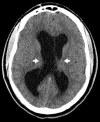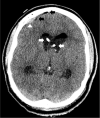A Rare Cause of Headache and an Unorthodox Transfer: A Case Report
- PMID: 36859324
- PMCID: PMC9983335
- DOI: 10.5811/cpcem.2022.10.57491
A Rare Cause of Headache and an Unorthodox Transfer: A Case Report
Abstract
Introduction: Emergency department (ED) crowding and hospital diversion times are increasing nationwide, with negative effects on patient safety and an association with increased mortality. Crowding in referral centers makes transfer of complex or critical patients by rural emergency physicians (EP) more complicated and difficult. We present a case requiring an unorthodox transfer method to navigate extensive hospital diversion and obtain life-saving neurosurgical care.
Case report: We present the case of a previously healthy 21-year-old male with two hours of headache and rapid neurologic decompensation en route to and at the ED. Computed tomography revealed obstructive hydrocephalus recognized by the EP, who medically managed the increased intracranial pressure (ICP) and began the transfer process for neurosurgical evaluation and management. After refusal by six referral centers in multiple states, all of which were on diversion, the EP initiated an unorthodox transfer procedure to the institution at which he trained, ultimately transferring the patient by air. Bilateral external ventricular drains were placed in the receiving ED, and the patient ultimately underwent neurosurgical resection of an obstructive colloid cyst.
Conclusion: First, our case illustrates the difficulties faced by rural EPs when attempting to transfer critical patients when large referral centers are refusing transfers and the need for improvements in facilitating timely transfers of critically ill, time-sensitive patients. Second, EPs should be aware of colloid cysts as a rare but potentially catastrophic cause of rapid neurologic decline due to increased ICP, and the ED management thereof, which we review.
Conflict of interest statement
Figures



Similar articles
-
Postexercise Death Due to Hemorrhagic Colloid Cyst of Third Ventricle: Case Report and Literature Review.World Neurosurg. 2019 Mar;123:351-356. doi: 10.1016/j.wneu.2018.12.057. Epub 2018 Dec 24. World Neurosurg. 2019. PMID: 30590211 Review.
-
Effect of an independent-capacity protocol on overcrowding in an urban emergency department.Acad Emerg Med. 2009 Dec;16(12):1277-1283. doi: 10.1111/j.1553-2712.2009.00526.x. Epub 2009 Nov 12. Acad Emerg Med. 2009. PMID: 19912131
-
Third ventricular colloid cyst causing acute hydrocephalus during early pregnancy: Clinical lessons from a case.Surg Neurol Int. 2021 Feb 10;12:54. doi: 10.25259/SNI_724_2020. eCollection 2021. Surg Neurol Int. 2021. PMID: 33654557 Free PMC article.
-
Delayed hydrocephalus after excision of a colloid cyst: a case report.J Med Case Rep. 2022 Jun 7;16(1):226. doi: 10.1186/s13256-022-03453-0. J Med Case Rep. 2022. PMID: 35668448 Free PMC article.
-
Out-of-third ventricle colloid cysts: review of the literature on pathophysiology, diagnosis and treatment of an uncommon condition, with a focus on headache.J Neurosurg Sci. 2019 Jun;63(3):330-336. doi: 10.23736/S0390-5616.16.03831-5. Epub 2016 Sep 7. J Neurosurg Sci. 2019. PMID: 27603409 Review.
References
-
- Berg LM, Ehrenberg A, Florin J, et al. Associations between crowding and ten-day mortality among patients allocated lower triage acuity levels with need of acute hospital care on departure from the emergency department. Ann Emerg Med. 2019;74(3):345–56. - PubMed
-
- Epstein SK, Huckins DS, Liu SW, et al. Emergency department crowding and risk of preventable medical errors. Intern Emerg Med. 2012;7(2):173–80. - PubMed
-
- Kelen G, Peterson S, Pronovost P. In the name of patient safety, let’s burden the emergency department more. Ann Emerg Med. 2016;67:737–40. - PubMed
-
- Centers for Disease Control and Prevention. National Hospital Ambulatory Medical Care Survey 2016 Emergency Department Summary Tables. 2021. [Accessed June 6, 2022]. Available at: https://www.cdc.gov/nchs/data/nhamcs/web_tables/2016_ed_web_tables.pdf.
LinkOut - more resources
Full Text Sources
Research Materials
